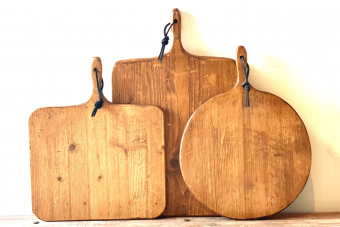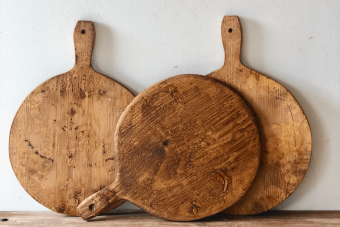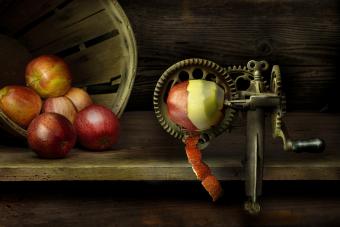
Say the words 'French bread board,' and you can practically smell the rich aroma of baguettes fresh from the oven. Perhaps this blissful sensory daydream is what entices people to collect vintage boards in the first place, but there's more than just that to keep collectors interested.
Use Of Bread Boards
No French home is complete without a baking oven, and bread boards are a necessary tool when baking different types of breads. Some boards are huge enough to accommodate ten or twelve big round loaves of bread and have a handle on one end, so they can be used to transport large baked items to and from the ovens. Others are long and skinny and are the perfect size for a single baguette.
Still, other boards are used to place slices of bread on the table; this type of bread board is the smaller, round bread board that was sometimes carved around the edges. Vintage (approximately 50 years old) and antique (more than 50 years old) bread boards are fun to collect, and they can easily be put to work in anyone's kitchen.
Identifying French Bread Boards

Bread boards come in different shapes and sizes that make them ideal for specific uses.
- Large bread boards - The large round bread boards used for transporting multiple loaves in and out of the oven measure approximately 23 to 28 inches in diameter. They're often made of pine, oak, or maple, and they've been in use for thousands of years. Some people call these boards pizza boards, but pizza boards are normally shaped more like a shovel, while bread boards are round.
- Boulangerie boards - Boulangerie bread boards are usually rectangular with a smaller handle on the end. They typically measure 26 to 30 inches long, approximately 1/2 inch thick, and are usually 16 inches wide. They're used in boulangeries, which are bakeries that specialize in baking bread. The boards are made of hardwoods such as maple, pine or walnut.
- Baguette boards - Baguette bread boards are at least 24 inches long. This type of board usually has a scooped indentation down the center that keeps the baguette in place while it's being cut.
- Family bread boards - Bread boards for the family table are a fairly uniform plate size. These round boards are often decorated with a homey phrase around the outside edge, such as "Donnez nous notre pain quotidien" which translates to "Give us our daily bread."
Materials Used to Make Bread Boards
The materials used for early French bread boards have changed over time.
- Early bread boards - Early bread boards were typically made from pine, maple, walnut, butternut and, sometimes, oak.
- Modern bread boards - More contemporary bread boards are made from walnut, mahogany, bamboo or a mix of two woods.
French Bread Board Makers
Early bread boards were normally made either by someone in the household or by the people working at the bakery. However, some were manufactured. For example, Bérard of France has been making bread boards and other wooden items for the kitchen since 1892. The company uses beech wood, box wood and cherry wood from certified forests, and it utilizes 100% of the wood it harvests for its products. Unfortunately for collectors, very few vintage bread boards were signed by the maker since these boards weren't considered works of art.
Every home owned one or two bread boards which were carved by the man of the family and used by the family as a utilitarian piece. Early boards are roughly carved, and the handle that is used to hang the board usually shows the marks of the tool used to create it. Some were even originally part of some other object and not meant to be a bread board from the start. For example, there are a number of bread boards for sale that were originally the tops of wooden barrels, but their shape and size made them perfect for re-purposing as bread boards.
Vintage or New?

Bread boards aren't usually signed by their maker, so if you see a signature and the board is glossy or well-oiled, be suspicious of its age. Older bread boards usually show signs of frequent use. Look for:
- Knife marks
- Little chips out of the edge of the board itself
- Darkening on the side that was used more often
- A softening or worn spot in the center of the board
The new boards are often made of walnut and are much darker and smoother than vintage baguette boards. The major difference is that contemporary bread boards look more polished and are less likely to show wear from many years of family gatherings and long hours baking.
Finding Bread Boards
Once you've fallen in love with wooden bread boards, you'll need to know where you can find them.
Antique Shops
Antiques shops, especially those that ship some of their goods by container from Europe, are the best place to find vintage French bread boards. The brick and mortar shops are best because if you can't find what you're looking for, you can ask the owner to search for you using their connections. Antiques dealers are immersed in finding items because they can't just call a factory and say, "Make me some vintage bread boards." Dealers visit auctions, other dealers' establishments, and often buy households full of goods, as well as finding contacts to bring antiques in from other countries. Make friends with your local dealer!
eBay
eBay is a huge online source for specific items. Conduct a search and use all the terms to find the board you want. For instance, if you want to see everything that's available, search for "vintage French bread boards." If you just want a circular one, search for "circular bread boards," but remember that the ones you find will be all the circular bread boards, so you'll have to go through your search results to see if any of them are actually French. Some eBay dealers advertise items that you can purchase immediately, while others conduct an auction. Just be careful not to get caught up in auction bidding and wind up spending too much for your board.
Etsy
Etsy is a group of online shops where dealers sell everything from homemade bookmarks to designer pieces of furniture. A recent search for "vintage French bread boards" netted almost 100 dealers who had some kind of French bread board for sale. Some were vintage, some were new, and some were antique, but all were interesting.
Specialty Dealers
Specialty dealers sell their items online, and you can conduct a simple online search for "vintage French bread boards" and discover dealers who regularly sell these tools. For example:
- Elsie Green - This company sells items for the house from all over the world (and they ship internationally). They offer bread boards they collect from flea markets across the French countryside. Their listings vary depending on availability, so check back often to see what's in stock.
- One Kings Lane - This is another website that has a small-but-nice selection of French bread boards. Their inventory changes regularly, so check back with them.
- Ruby Lane - Ruby Lane is composed of a group of dealers who share a website, and they have a revolving selection of boards as well. As with most antique sites, you may need to check back on a regular basis to catch these boards when they're in stock.
Dealers/decorators who specialize in French antiques also usually have a couple of bread boards in their inventory.
Tips for Pricing Antique Bread Boards

Two elements determine price when you're collecting vintage items: age and condition. When collecting wood items that were work horses, welcome those splits in the wood, those wormholes, that uneven handle. All of these elements add character to work-day items that make them even more valuable to collectors and even more loved by chefs who still embrace old tools and tried-and-true recipes.
Compare a few price examples.
- Large round bread boards made in the 19th century sell between $120 and $350, depending upon their condition.
- Baguette bread boards aren't as desirable as the larger ones. You might find some good examples for $20 to $55.
- Round, single loaf boards carved with a saying around the edge are highly collectible and range from $30 to $130, depending on the age and how attractive the carving is.
- Painted bread boards made during the 1930s to 1940s typically fetch $25 to $55, depending on how they're decorated.
Note: These prices are averages for items sold on eBay and other sources referenced in this article.
How to Determine a Board's Age
Most of the vintage French bread boards you'll find for sale today date from the late 1700s (ca. 1780) to the mid 1940s. The large round bread boards usually date from the 19th century. After the turn of the century, home bakers (and larger bakeries) began making their bread in tins or cast iron pans instead of on the floor in brick ovens. The bread board handles were shortened, and the boards were made smaller since bakers didn't need to carry several loaves on the one large round bread board they had previously used.
Hardware + Wear and Tear
Wood tends to soften around the edges as it ages, so the edges of an old board are usually sloped and will show wear from years of heavy cutting and knife work. The older bread boards might have small worm holes that tell you the wood is older than the newer boards, which were sometimes sealed.
Newer boards made after the turn of the century often have shorter handles or no handles at all. Some of the smaller boards made in the 1930s and 1940s also have decals on them, such as apples or other colorful fruits. The "newer" boards (still considered vintage) also come in various animal shapes, such as pigs or fish. Wood shrinks across the grain, so some boards may show cracks after years of washing.
Hand Carved vs. Machine Made

The round boards meant for the dinner table and carved with a household saying have been made since the late 1800s. The older the board, the more likely that the words were hand carved, which gives them a slightly uneven look. As a board ages, the edges of the carving soften, too; sometimes the letters actually disappear because they've been worn down with use.
Presence of a Patina
Finally, patina is important when determining age. Wood normally darkens as it ages, so a pine board will look almost as dark as mahogany board when the board is used regularly. The good thing about collecting wooden bread boards is that they grow more beautiful with time!
Best Ways to Care for Your Bread Board
If you're lucky enough to find a vintage or antique bread board, be sure to care for your treasure properly using these quick tips:
- Scrub it with soap and water - After every use, quickly scrub the board in hot water with dish detergent. Don't let it soak, or it will likely warp!
- Keep it stored away from moisture - Too much moisture can be damaging to your bread board's wood, so it's important to make sure that you've fully dried off your board after cleaning it.
- Nourish the wood monthly - Oil the board once a month with a mixture of mineral oil and beeswax or a thin sheen of cooking oil. Let the oil soak in overnight and then wipe off the excess.
How to Expertly Mix the Old With the New
Given that there's only so many opportunities any one person has to break out their wooden bread board a day, it might seem like your bread board is going to waste just sitting in a cabinet for weeks on end. If you're worried that you're not getting enough use out of your antique bread board, then you're in luck. DIY is trendier than ever, and with a few easy steps, even the most inexperienced wannabe interior designer can show off their antiques in style.
Hanging Art
No matter their size, antique French bread boards can easily be transformed into beautiful hanging displays for your kitchen, living room, or dining area. Using twine, rope, or leather, you can hang your board up for both storage and decoration. Or, if you're not planning on using it too often, take to painting your board with whatever design strikes your fancy and sealing it so that it'll be food safe for future use.
Botanical Garden
If you're not thinking about using your board for its intended purpose, you can absolutely use it for a botanical twist. Using store bought hinges, you can mount your bread boards to the wall to turn them into a shelf that's perfect to store all of your plant babies on. Granted, this idea works best with wooden or baguette bread boards, but round boards will work in a pinch too.
Break Bread With Your Friends in Style
One of the beautiful things about collecting these lovely wooden boards is that each one is different. All of them have aged in their own distinct way, so you will never find any two that look the same. Remember that the first rule in collecting is to buy something that you love. If you can display your bread board and/or use it, all the better, but love it first!







